There were 4 posts tagged: Side by Side
Train with wireless headsets and maintain social distancing
The COVID-19 pandemic has fundamentally changed the work place: some were sent home to work and will stay there; others working in the office have new rules to follow.
To limit virus spread, the CDC recommends limited face-to-face contact. As people return to the office, the CDC-recommended social distancing, also called “physical distancing,” (keeping a safe space between yourself and other people who are not from your household) is in effect. To practice this distancing, workers must stay at least 6 feet (about 2 arms’ length) from others.
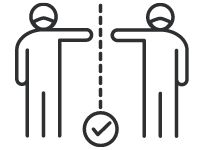 For call centric employees, side by side training is a necessity; yet, how can we accomplish this in the office, at a safe distance?
For call centric employees, side by side training is a necessity; yet, how can we accomplish this in the office, at a safe distance?
Fortunately, the technology in most DECT wireless headsets allows "call conferencing" between units. This is a great feature that allows employees to drop into calls for training or conference call purposes, with minimal contact.
1. Remove the primary/host headset from the base.
2. Drop the secondary/guest headset into the headset cradle. The host headset will hear a tone to accept the new headset. The host headset will click the "Answer/End" button.
3. Remove the guest headset from the host base. The headsets are now paired and ready to work together. This process can be repeated for an additional 2 headsets, for a total of 4 headsets on the same call.
4. The guest headset can be muted for listening purposes; simply unmute if necessary.
5. To end the conference/pairing feature, press the End button on the primary/host headset. It's that simple!
If you deploy corded headsets to your employees, you’ll want to explore options beyond traditional side by side training. Perhaps your current softphone solution offers listen-in type features that you can take advantage of for training purposes.
For questions about wireless headsets in the contact center environment, or suggestions for the best wireless headsets for your unique set-up, call our Headset Experts at 1-866-998-9991 or Chat us now!
To limit virus spread, the CDC recommends limited face-to-face contact. As people return to the office, the CDC-recommended social distancing, also called “physical distancing,” (keeping a safe space between yourself and other people who are not from your household) is in effect. To practice this distancing, workers must stay at least 6 feet (about 2 arms’ length) from others.
 For call centric employees, side by side training is a necessity; yet, how can we accomplish this in the office, at a safe distance?
For call centric employees, side by side training is a necessity; yet, how can we accomplish this in the office, at a safe distance?Fortunately, the technology in most DECT wireless headsets allows "call conferencing" between units. This is a great feature that allows employees to drop into calls for training or conference call purposes, with minimal contact.
Call training is easy — and safe — when you use wireless headsets.
Here's how:1. Remove the primary/host headset from the base.
2. Drop the secondary/guest headset into the headset cradle. The host headset will hear a tone to accept the new headset. The host headset will click the "Answer/End" button.
3. Remove the guest headset from the host base. The headsets are now paired and ready to work together. This process can be repeated for an additional 2 headsets, for a total of 4 headsets on the same call.
4. The guest headset can be muted for listening purposes; simply unmute if necessary.
5. To end the conference/pairing feature, press the End button on the primary/host headset. It's that simple!
If you deploy corded headsets to your employees, you’ll want to explore options beyond traditional side by side training. Perhaps your current softphone solution offers listen-in type features that you can take advantage of for training purposes.
For questions about wireless headsets in the contact center environment, or suggestions for the best wireless headsets for your unique set-up, call our Headset Experts at 1-866-998-9991 or Chat us now!
Recommendations for Softphone Side by Side Training
USB headsets simplify the set-up for daily use at the agent's PC, Thin Client, etc. It's easy to plug-and-work with these headsets for daily use; however, when side-by-side training is necessary, a frequent question that we receive is: "Can I do side-by-side training using USB headsets?"
The answer: You cannot!
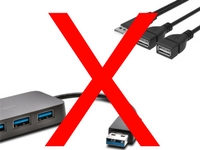 While there are USB hubs and USB adapters/splitters (male USB to dual female USB plugs) on the market, they are not built for the distribution of sound. These cables are typically for power transfer and some carry data.
While there are USB hubs and USB adapters/splitters (male USB to dual female USB plugs) on the market, they are not built for the distribution of sound. These cables are typically for power transfer and some carry data.
Another thought is to simply plug 2 USB headsets into the PC at the same time; unfortunately, the PC can only push sound through 1 device at a time.
When our customers ask us how to achieve side-by-side training in a softphone environment, our recommendation and only option is to purchase QD headsets.
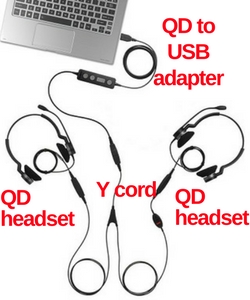
The image to the right shows how this training set-up would look. In this example, Jabra Biz 2300 headsets and the Link 260 with call controls are pictured; however, it would be a similar arrangement for Plantronics, Sennheiser and VXi products.
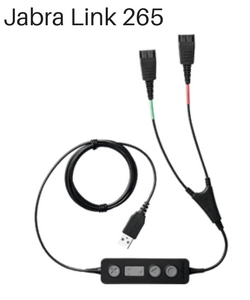
There is a USB Y cord unique to Jabra, the Link 265, which connects 2 QD headsets and ends in USB. This cuts out one step in the above pictured set-up, but is only available from Jabra, and is compatible with Jabra QD headsets. The Link 265 has a module that controls sound distribution, and the in-line call controls are a nice touch. This QD USB Y cord was created for softphone training!
We are happy to discuss your unique training needs, and provide recommendations based on your requirements. Contact us today: 1-866-998-9991 or email us.
The answer: You cannot!
 While there are USB hubs and USB adapters/splitters (male USB to dual female USB plugs) on the market, they are not built for the distribution of sound. These cables are typically for power transfer and some carry data.
While there are USB hubs and USB adapters/splitters (male USB to dual female USB plugs) on the market, they are not built for the distribution of sound. These cables are typically for power transfer and some carry data. Another thought is to simply plug 2 USB headsets into the PC at the same time; unfortunately, the PC can only push sound through 1 device at a time.
When our customers ask us how to achieve side-by-side training in a softphone environment, our recommendation and only option is to purchase QD headsets.

Our recommendations for side-by-side training:
The least expensive Training setup is to utilize the Jabra BIZ 1500 QD’s, the Jabra Link 230 (no volume control) and the VXi Training Y cord. If you need volume control while training, then we would recommend purchasing the Jabra Link 265, along with 2 Biz 1500 QD headsets.The image to the right shows how this training set-up would look. In this example, Jabra Biz 2300 headsets and the Link 260 with call controls are pictured; however, it would be a similar arrangement for Plantronics, Sennheiser and VXi products.

There is a USB Y cord unique to Jabra, the Link 265, which connects 2 QD headsets and ends in USB. This cuts out one step in the above pictured set-up, but is only available from Jabra, and is compatible with Jabra QD headsets. The Link 265 has a module that controls sound distribution, and the in-line call controls are a nice touch. This QD USB Y cord was created for softphone training!
We are happy to discuss your unique training needs, and provide recommendations based on your requirements. Contact us today: 1-866-998-9991 or email us.
Options for Side by Side Training with Headsets
Contact center staff members are at the front lines of engagement with your customers. Their success translates into happy customers, which is is why it's imperative to provide valuable, hands-on training from the start. If the new staff members will work on the phone, side by side training is especially a must; however, how the training is delivered depends upon several factors. Here's what you need before your new staff members arrive!
Training new staff, ongoing staff training, and supervisor drop-ins are all situations that are common in contact centers. Training cables (also known as supervisory cords, Y cords, or splitters) connect to Quick Disconnect (QD) headsets only. So if you are planning to roll out USB all-in-one headsets for your environment, make sure to order separate QD training set-ups. Currently, there is no side by side training set-up for all-in-one USB headsets.
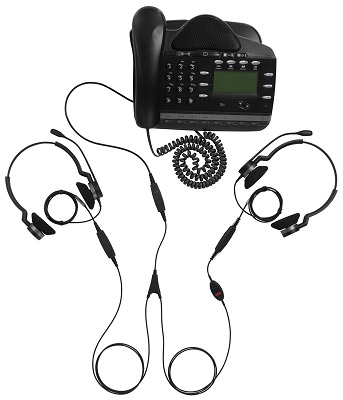
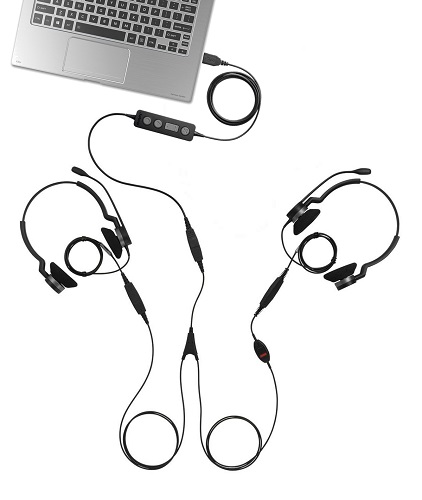
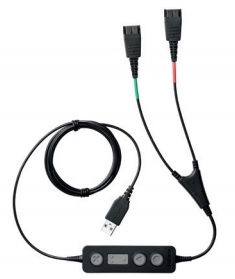
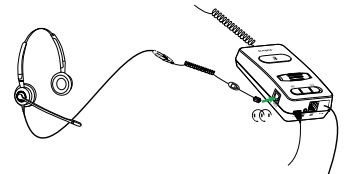
 The conferencing feature of wireless headsets allows connection of up to 4 (the primary headset + 3 additional) wireless headsets to a single base.
The conferencing feature of wireless headsets allows connection of up to 4 (the primary headset + 3 additional) wireless headsets to a single base.
With the primary headset in use, simply drop the second headset into the base. Once the secondary headset has been paired to the base, a tone will sound in the primary headset, and that headset must hit "Answer" to accept the secondary headset. To unpair, or disconnect the secondary headsets, simply dock them back into their own bases.
Read our complete blog post on how to accomplish training with wireless headsets, here: How to: Side by Side Training with Wireless Headsets.
We are always happy to walk you through this over the phone as well – give us a call anytime at 1.866.998.9991.
Training new staff, ongoing staff training, and supervisor drop-ins are all situations that are common in contact centers. Training cables (also known as supervisory cords, Y cords, or splitters) connect to Quick Disconnect (QD) headsets only. So if you are planning to roll out USB all-in-one headsets for your environment, make sure to order separate QD training set-ups. Currently, there is no side by side training set-up for all-in-one USB headsets.
Desk Phone Training
To begin, here's a traditional training set-up: a desk phone, 2 QD headsets connected to one direct connect lower cable by way of a Y cord. The Y cord shown has an inline mute switch, so that the second person can be either muted for listening to the conversation, or live, depending upon the situation. Depending upon the brand, Y cords can also have one side that's always muted.
Softphone Training
Training setups for the computer can be done a couple of ways. One is similar to the above mentioned desk phone setup. For example, in this image, there are two quick disconnect headsets, one Y-cord, and one QD to USB connection cable to the laptop (in this case, a Link 260). Another option is the Jabra Link 265.
Link 265
This Y-cord is the only one of its kind. The Link 265 from Jabra is a Y-cord that ends in USB. Connect two QD headsets to the Link 265 and connect via USB. It's that simple ... and cuts out one cord from the set-up above.
Amplifier Training
The Jabra Link 860 amplifier has a guest port for supervisors to connect into. Using the Link 850/860 QD Supervisory Cord with in-line mute, supervisors can immediately drop into a call and have the same functions as the primary headset.
Wireless Headsets
 The conferencing feature of wireless headsets allows connection of up to 4 (the primary headset + 3 additional) wireless headsets to a single base.
The conferencing feature of wireless headsets allows connection of up to 4 (the primary headset + 3 additional) wireless headsets to a single base. With the primary headset in use, simply drop the second headset into the base. Once the secondary headset has been paired to the base, a tone will sound in the primary headset, and that headset must hit "Answer" to accept the secondary headset. To unpair, or disconnect the secondary headsets, simply dock them back into their own bases.
Read our complete blog post on how to accomplish training with wireless headsets, here: How to: Side by Side Training with Wireless Headsets.
We are always happy to walk you through this over the phone as well – give us a call anytime at 1.866.998.9991.
How to: Side by Side Training with Wireless Headsets
 With a wireless headset, employees can work from their desk just as before, but now have the ability to leave their desks whenever necessary to test, consult, or refer to resources elsewhere in the office while continuing the conversation with the customer. Wireless headsets de-clutter the workstation, and eradicate the fluid spills, snagging and general inconvenience associated with cords.
With a wireless headset, employees can work from their desk just as before, but now have the ability to leave their desks whenever necessary to test, consult, or refer to resources elsewhere in the office while continuing the conversation with the customer. Wireless headsets de-clutter the workstation, and eradicate the fluid spills, snagging and general inconvenience associated with cords. Another really great benefit of most wireless headsets: supervisors can move freely among agents in the call center and guide their work, joining calls on the fly without the need for Y cables and physical interruption.
Many of the headset manufacturers refer to this feature as "headset conferencing."
Side by side training is easy when you use wireless headsets.
Here's how:
1. Remove the primary/host headset from the base.
2. Drop the secondary/guest headset into the headset cradle. The host headset will hear a tone to accept the new headset. The host headset will click the "Answer/End" button.
3. Remove the guest headset from the host base. The headsets are now paired and ready to work together. This process can be repeated for an additional 2 headsets, for a total of 4 headsets on the same call.
4. The guest headset can be muted for listening purposes; simply unmute if necessary.
5. To end the conference/pairing feature, press the End button on the primary/host headset. It's that simple!
If you have questions about wireless headsets in the contact center environment, contact us!

